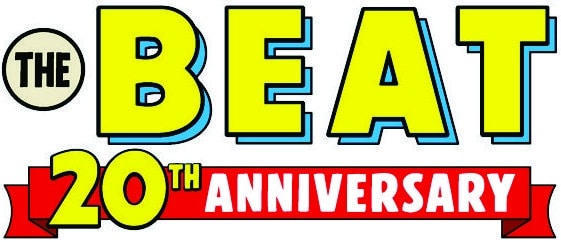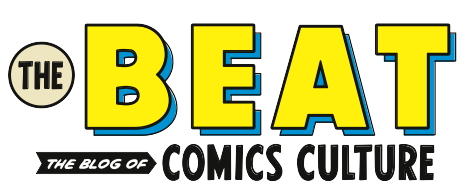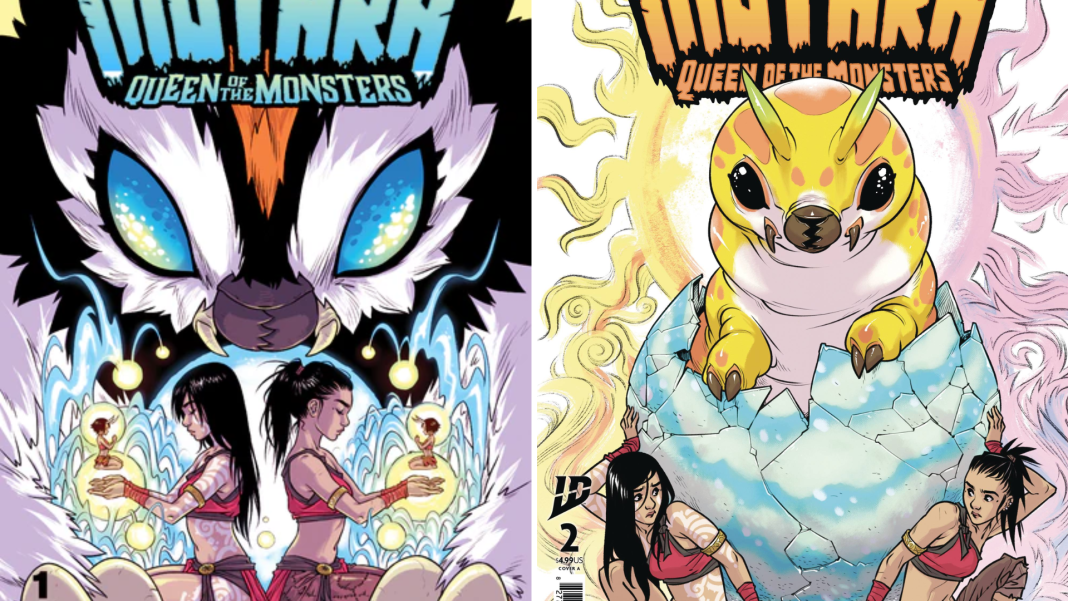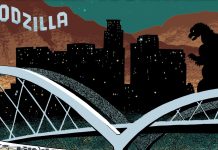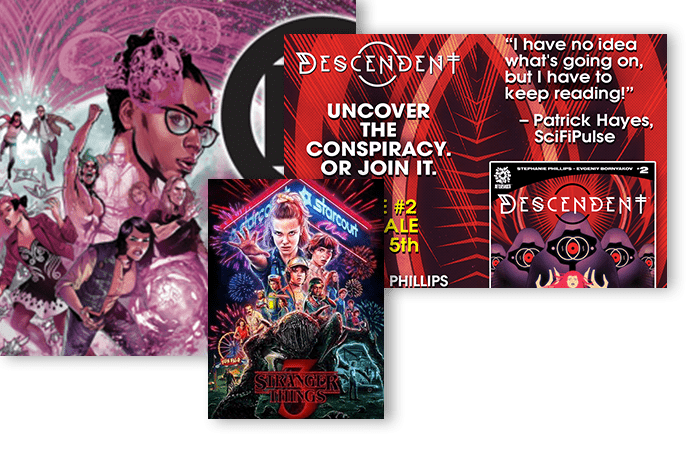Mothra: Queen of the Monsters #1 debuted this month, generating a lot of buzz and earning high praise.
Written and illustrated by Sophie Campbell and Matt Frank, the series focuses on a dystopian, post-Mothra world, and specifically the adventures of two twin sisters trying to save it by going back in time to bring the illusive Mothra Gemini to their future. With incredible artwork from both creatives, and a narrative that’s exciting and easy to invest into, the book is the first ever Mothra solo series and a great way to kick off her solo career. We sat down with writer / artist Sophie Campbell to discuss some of the background to the series, its uniquely organic creative process, and how brilliant kaiju are.
This interview has been transcribed and edited for clarity.
Sophie Campbell talks Mothra: Queen of Monsters
JARED BIRD: Hello and thank you so much for your time. Mothra: Queen of the Monsters #1 came out last week, March 5th 2025, and will run for five issues. To those who might be unfamiliar with the character, how would you describe the appeal of Mothra?
SOPHIE CAMPBELL: That’s complicated. She’s a giant moth and wrecks cities, which is just so cool. She has twin fairy priestesses, called the Shobijin, and they sing a song to summon her which is awesome. She fights for the earth and has no regard for humans really. She destroys capitalism in a lot of her movies too.
BIRD: If Gamera is always fighting for people, and Godzilla is always destroying something, she exists somewhere in between.
CAMPBELL: In the very first 1961 Mothra film, the Shobijin get captured and summon Mothra to save them. She goes and levels the city to try and get her fairies back, and you know, they go and give them back and it’s fine! Mothra as an avatar of nature didn’t really come along until a bit later, at first she purely defended her tiny ladies. You could argue that the twin fairies represent nature, when these evil businessmen come in and try to exploit them and turn them into a sideshow, that’s representative of the capitalistic disregard for mother nature, you could say. Then Mothra comes in and destroys everything as retribution, which is great and which I love. We mostly focus on her as an avatar of nature in our series. I almost wish we did more of her destroying everything to protect her priestesses.
BIRD: Mothra smashes capitalism.
CAMPBELL: For sure!
BIRD: Part of the appeal of kaiju in general is that they are these awesome, world-destroying monsters that look cool, but you can also read into them as metaphors and as an abstract way of discussing a complex topic.
CAMPBELL: They’re kind of like a way to imagine tackling and bringing down a system that’s too big for one person to challenge. Any systemic issues in society can be destroyed by a kaiju. They come in, level it and leave. There’s an appeal in that, and it brings these problems to the forefront.

BIRD: This is the first ever Mothra comic series. Did you feel any pressure going into the project?
CAMPBELL: Not really. It’s all been really breezy. It’s a Mothra comic, that’s awesome, and I feel like we have a really great idea and it all just flowed out of Matt Frank and I. The main pressure is whether Godzilla should show up. That was the main question that was on our minds. We figured fans would be looking for Godzilla and when he showed up. People want them to always go together, whether they’re fighting or they’re friends. That’s the main pressure.
BIRD: A lot of people who’ve only encountered her through the Monsterverse movies may not be familiar with her being a character of her own with solo movies. She’s not just supplementary to Godzilla.
CAMPBELL: She’s shown up in a lot of his movies, but she has her 1961 solo movie as well as the Rebirth of Mothra trilogy, which is awesome and was the main touchstone for our series.
BIRD: You could do way worse for an influence than that. What was it like to work with Matt Frank?
CAMPBELL: It has been great. We used to do these kaiju redesign challenges where we would pick a character and both do our own design sheets with different ideas. We were acquainted with each other already and the process of batting ideas around. ‘What if this character could do this?’ and stuff like that. With Mothra, it’s been more of that. ‘What if Gorosaurus shows up here?’ and that kind of thing. We are constantly in contact and we are always tossing ideas around and sending each other sketches.
BIRD: His artwork for the series has been incredible. The traditional method has given the dystopian, post-Mothra period this beautiful contrast between washed out, grey environments and this bright, destructive kaiju. What was the creative process behind Mothra Gemini’s design like?
CAMPBELL: It was based on a sketch I did a few years ago. Originally, I had pitched this to a previous editor to write and draw myself. He moved on to another company, so I shelved the pitch. I had done the Mothra Gemini design for that, because I wanted to draw her super fluffy. LIke a real moth. A big fluffy mane. When Matt came aboard, we started from that same sketch and took it and did his own thing with it. Then I took it and did my own thing with it and we worked back and forth with each other figuring out the design that way.
BIRD: Did the story come from the sketch or was the sketch designed with the story in mind?
CAMPBELL: It was originally a Godzilla pitch. ‘How can I do a Godzilla story without drawing buildings, crowds of people and military vehicles?’. That’s where the post-apocalyptic wasteland idea started, and at some point I felt like there was so much Godzilla media and I didn’t have anything to say that hadn’t already been done better. I didn’t know where to take the character, and at some point I decided to focus on Mothra instead, who felt like a better fit for me. A bit more over the top, with a big magical element. It seemed like a no-brainer. I transported her into this post-apocalyptic setting, and never really wrote a full treatment before I shelved it.
When Matt came aboard he expanded it into a full pitch. The basic design of Mothra Gemini has remained pretty set in stone since that early sketch I did. Her larva form definitely changed though. Originally we were going to do the classic, brown beady caterpillar, but at some point I decided it should be different. I considered making it even fluffier, like a Wooly Caterpillar, the ones that curl up when you touch them. We were looking at other caterpillars in the real world and a lot of them are really bright colors to deter predators. That’s where the Mothra Gemini larva came from with the bright yellow look.
BIRD: It’s a great design. Your issue #2 cover is gorgeous.
CAMPBELL: That’s how a lot of our work begins. I did a little doodle of a Mothra larva curled up and sleeping, showed it to Matt and he turned around and said ‘no, that’s our larva right there.’ His ideas springboarded off of it.
BIRD: It sounds like every step of the process was a super collaborative one, which I can imagine as a creator is so exciting to do. It’s not just ‘artist does this, writer does that’.
CAMPBELL: I’ve done work where the script just gets handed off to the artist, whether that’s me or someone else, and there’s zero conversation about it and I’m never actually talking to the other person. With Matt, he will have notes on my script which I enjoy. Most of the time! It’s very fluid and collaborative and I like that I can do a quick sketch of something silly and he will take it and turn it into something real.

BIRD: The twins, Emi and Mira, have completely different views on Mothra, causing some tension between them. What inspired the siblings’ dynamic?
CAMPBELL: Originally the pitch was about the Shobijin exclusively. They had this difference of opinion on how to engage with Mothra. During the process we decided not to do that, and decided to have twin humans with the Shobijin as their mentors. The main thing I wanted to do was have the two main characters try to sing the Mothra song and not be able to do it because they aren’t in harmony with each other. One of them was to be cheery and happy and totally on Mothra’s level, and the other one would have the attitude of ‘ugh, this sucks’.
BIRD: It’s a fun dynamic. The contrast between the overexcitable ‘Let’s go to the past and save Mothra and it’ll all be amazing’ versus ‘Really? It is going to be fun?’
CAMPBELL: Yeah, It’s not just Mira trying to get on Emi’s level. I didn’t want one twin to be perfect right off the bat. They have to get on each other’s level and in doing that, they get on Mothra’s level.
BIRD: The series introduces a new kaiju, Antra. What tips would you give to artists and writers trying to create and design their own monsters?
CAMPBELL: I don’t feel like there are any rules, really. Especially if it’s a monster for a comic. You aren’t limited by having a human being inside the costume, or by the CGI budget. If you’re drawing it, the sky’s the limit. I have my own personal gripes and likes, but that’s just me. That might be bad advice but don’t limit yourself. It doesn’t have to fit into real life, or real animals, or real biology. You can do whatever you want, it doesn’t matter.
BIRD: I remember reading an article on people complaining about the aliens in James Cameron’s Avatar movies, and how they couldn’t physically have six limbs, and his response was like ‘Well, they just do. I don’t care.’
CAMPBELL: Yeah! Who gives a shit. It’s just cool, it doesn’t matter. Kaiju aren’t bound by real life logic. A lot of Ultraman monsters are just bonkers.
BIRD: In Neon Genesis Evangelion, one of the kaiju is a glass diamond floating around.
CAMPBELL: Yeah, and it’s awesome!

BIRD: What influenced the prehistoric setting?
CAMPBELL: That was mostly my love of time travel and dinosaurs. It was part of the older pitch, where I would be drawing it, and if it went to prehistoric times I wouldn’t have to draw any buildings. With the prehistoric setting, I get to see Matt draw dinosaurs. All of the dinosaurs are prehistoric versions of Toho kaiju, which you can see briefly at the end of issue #1. Titanosaurus and Varan and similar stuff. ‘I want to see Matt draw Gorosaurus, so he’s going to show up!’. In Rebirth of Mothra III, there’s really cool prehistoric Mothra larva, which I wanted to link to as well. Here’s a list of things I want to see Matt draw, and that’s the issue.
BIRD: You mentioned your life of time travel stories, which you’ve explored in your other work as well. In my experience they can often become complicated and emotionally obtuse. How did you make sure the series stayed focused and impactful?
CAMPBELL: For me, my favorite time travel stories are closed causality loops. It’s not like Back to the Future where you can change things in the past to end up with a different future. There’s a causality loop, that’s the story. It’s the same as telling any other story. It’s got a beginning, middle and end. With a fixed causality loop, there’s a beginning, middle and end. We had to sit down with our editor Jake Williams because he’d be like ‘Wait, what?’ and we were like ‘Don’t worry, this is how it works!’. The best closed causality loop movie is a Spanish film called Timecrimes, and it’s very character driven. It has a mind boggling sci-fi core but is still focused on this one character throughout and his experiences. The key is for the time travel to happen because of the character, like in Terminator. Time travel is happening for this very emotionally driven reason. Michael Biehn goes back in time for a purpose. If you maintain that, it doesn’t get overtaken by the science of it all.
BIRD: It ultimately comes down to characters and plot and the link between. If there’s a reason the characters are partaking in it, it’s easy to buy into.
CAMPBELL: Yeah, they have a mission which they are trying to accomplish. Part of that mission is going back to prehistoric times!
BIRD: As a creative team, are there any other Kaiju you’d like to take on in a major project?
CAMPBELL: Gamera is the number one choice. That would be so great. I would drop everything to work on that. I would fight tooth and nail to get on that book. I would love to do another series on a lesser known Toho kaiju, like Varan. Matt loves Varan so that would be a lot of fun to do. Gabara from All Monsters Attack. No one likes Gabara but that would be so much fun to do. Daigoro, Rhodan, the lesser known kaiju who may not have their own movie or comic previously. Mechani-Kong from King Kong Escapes would be great to do, I love Mechani-Kong! Oh, I’d also love to do a Space Amoeba comic where Kamoebas, Ganime and Gezora team up to wreak havoc.
BIRD: Are there any other comics of yours that you would recommend to readers of Mothra: Queen of the Monsters?
CAMPBELL: My upcoming Supergirl comic would be a great fit, which comes out in May. Shadoweyes is monster-adjacent, so some people might like that. Glory should still be in print, and it’s on a similar wavelength to Mothra. I did make Monsters of Gruesome Glacier, a full-blown Kaiju mini-comic that came with the Redbite figure I designed. I’ve been working on a follow-up, but it’s taken some time.
BIRD: Thank you so much and have a lovely day.
CAMPBELL: You too!
